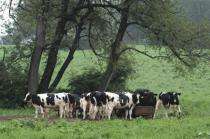Farmers, livestock, crops suffered through sizzling weather

(PhysOrg.com) -- Pennsylvania farmers were reeling from the effects of the recent heat wave plaguing the Northeast, according to experts in Penn State's College of Agricultural Sciences.
"The cows aren't getting a break -- even the nights are hot," said Michael O'Connor, professor emeritus of dairy science, during the peak of the steamy spell. "The hot weather is causing animals to reduce their appetites, resulting in a significant drop in production, and combined with the direct effect of increased body temperature, there is a substantial reduction in reproductive performance.
Meanwhile, near-drought conditions are causing crops to stop growing. "Most of our forages are 'cool season' grasses -- they don't grow well when the temperature is above 85 degrees," said Marvin Hall, professor of forage management. "Currently, they're sitting still."
However, "a pig barn is not a bad place to be for swine on a hot day!" said Robert Mikesell, senior instructor in animal science. "The confinement barns that house most of Pennsylvania's hogs are constructed with tunnel ventilation, where fans at the end of the long building blow indoor air to the outdoors. Fresh air enters from inlets at the other end of the barn."
The resulting "wind tunnel" effect can reduce temperatures by 10 degrees, he explained. Some barns are equipped with "cool cells" at the air inlets, which trickle water across a surface to take advantage of evaporative cooling. These barns can be even cooler.
Yet hot weather still detrimentally affects hogs, Mikesell conceded. Sows' estrous cycles can be thrown off, lengthening the reproductive cycle by over a month and causing a temporary shortage of market hogs several months in the future.
"With any hog, feed intake decreases during a hot spell," he said. "This causes loss of body condition, slows growth of market hogs and causes nursing sows to consume too little feed to support lactation while maintaining body condition."
Dairy cows similarly decrease feed consumption, causing milk production to drop. "In hot conditions, dairy cattle can decrease production by 8 to 10 pounds of milk per day, depending on the heat-abatement systems the farmer has installed," said O’Connor. "And for every 1 degree increase in core body temperature, the cow's conception rate decreases by 10 to 15 percent."
Furthermore, O'Connor warned, during the first several days to weeks following calving, cows are more susceptible to infectious diseases and metabolic disorders. Heat stress compounds the situation.
"Although most attention is devoted to improving the environmental conditions for lactating cows, the dry cows should not be ignored," he said. "Reducing heat stress in dry cows can improve milk production and reproduction during the subsequent lactation."
O'Connor advised dairy producers to install sprinklers and strategically locate fans if possible, but to definitely keep the barns well ventilated. Overcrowding can increase heat load and further aggravate the situation, due to the body heat produced by cows in close proximity. Even for producers who practice intensive grazing, O’Connor suggests conserving any remaining pasture by supplementing with stored forages such as hay or silage.
"An adequate supply of water must be maintained," he said. "Two strategies to improve dry-matter intake are to feed more frequently during the day and feed the cattle during the cooler hours of the day.
"Even with high-quality forage, though, you can't negate the effect of prolonged heat stress," noted O’Connor. "It's not a question of whether milk production will drop, just how much."
A warm spring season followed by cooler and wet weather in May and June allowed some Pennsylvania growers to produce record first-cutting forage yields. This abundance will offset some setbacks caused by the current weather pattern. Supplementing this forage for pastured animals can help maintain a healthy pasture.
"Cows can do quite a bit of damage by overgrazing," cautioned Hall. "Weakened plants can allow room for weeds to arrive."
Even though current conditions are tough, some facts may offer consolation. Drought-stressed alfalfa is a higher-quality plant despite less yield, as the leaf-to-stem ratio is higher, Hall pointed out. And, according to the state Department of Agriculture, Pennsylvania dairies produced 1.3 percent more milk in May of 2010 than in May of 2009, indicating more productivity.
"Still, the heat wave is another stress to dairies -- first low milk prices, now heat stress and lowered production," said O'Connor. "We won't see a price increase to compensate for lower production, either, because this weather is only affecting Pennsylvania, New York and other Northeastern states, and at this point, not other major milk producing states."
This period surpassed the Pennsylvania heat wave of 2005 in terms of intensity and duration and rivals several that occurred in the 1990s, Hall noted, pointing out that "Mother Nature's in control."
"With one year of bad weather like this, we'd be a starving country," he said. "We aren't top-of-the-heap as humans; we're just along for the ride."
Provided by Pennsylvania State University

















